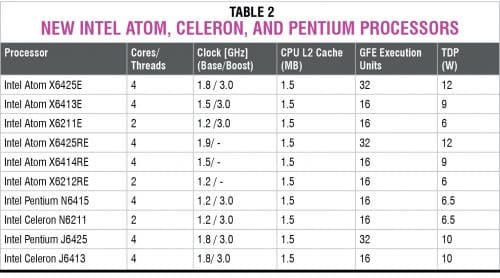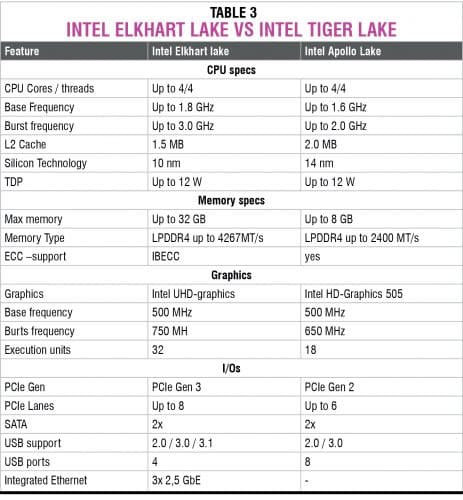Embedded applications with smaller footprints and reduced power requirements, such as SMARC, Qseven, COM Express Compact/Mini, and Pico-ITX SBCs, get a boost with the launch of Intel’s latest batch of Elkhart Lake processors. Replacing the previous Apollo Lake generation, they not only provide increased processing performance with decreased power requirements for industrial IoT applications, but also enable true real-time operation by supporting real-time connectivity and real-time hypervisor technology.
Delivering an impressive increase in performance, while requiring much less power, Intel’s Elkhart Lake based trio of low power processors—Atom, Celeron, and Pentium—accelerate multithreaded workload processing by +50% compared to the previous generation, due to implementation of new microarchitecture on four cores. For single-thread applications, the high clock rates of up to 3GHz are advantageous and help increase performance by up to +70%. This elevated processing performance can be leveraged in very cold and hot environments, with trouble-free operation from -40 to +85°C, which is very important for the industrial segment.
And with the introduction of Elkhart Lake, embedded applications can now take advantage of Intel’s 10nm SuperFin technology, which made its debut with this low-power Atom processor technology. Increased RAM support offers far more memory bandwidth and allows for much higher transfer rates. Up to 32GB LPDDR4 memory with data rates reaching 4267 MT/s, in contrast to 8GB LPDDR4 with up to 2400 MT/s from the previous generation, are now supported. The possibility to add additional memory capabilities with Intel’s budget-friendly Inband Error Correction Code (IBECC) is also a welcomed advantage for mission-critical real-time applications. Instead of using expensive, dedicated ECC memory modules, designers can leverage lower-cost conventional RAM. Setting the mode as ECC or non-ECC can be easily carried out in the BIOS, which means developers can choose which areas of memory will be assigned as IBECC.



Highly accelerated graphics performance with a small appetite
The latest generation of processors makes use of Intel‘s Gen11 graphics units, located on top of the CPU die, which double graphics performance to a maximum speed of 3x 4k @ 60fps and 10-bit colour depth. Once again, the use of 10nm technology in the manufacturing process allows for stunning high performance with low power requirements.
The greatest contributor to the doubling of performance is the increase of up to 32 integrated execution units (EUs) in the Gen11 graphics unit, compared to only 18 EUs found in the low-power Apollo Lake Gen9 unit. Moreover, improved compression, increased L3 cache, and higher data transfer rates lead to highly efficient operation, while providing more performance headroom for graphics-intensive applications.







